Maryland, defined by its coastal charm and thriving fisheries, proudly claims the rockfish (striped bass) as its official state fish. The rockfish holds a special place in Maryland’s identity with its majestic appearance, unique migratory patterns, and cultural significance.
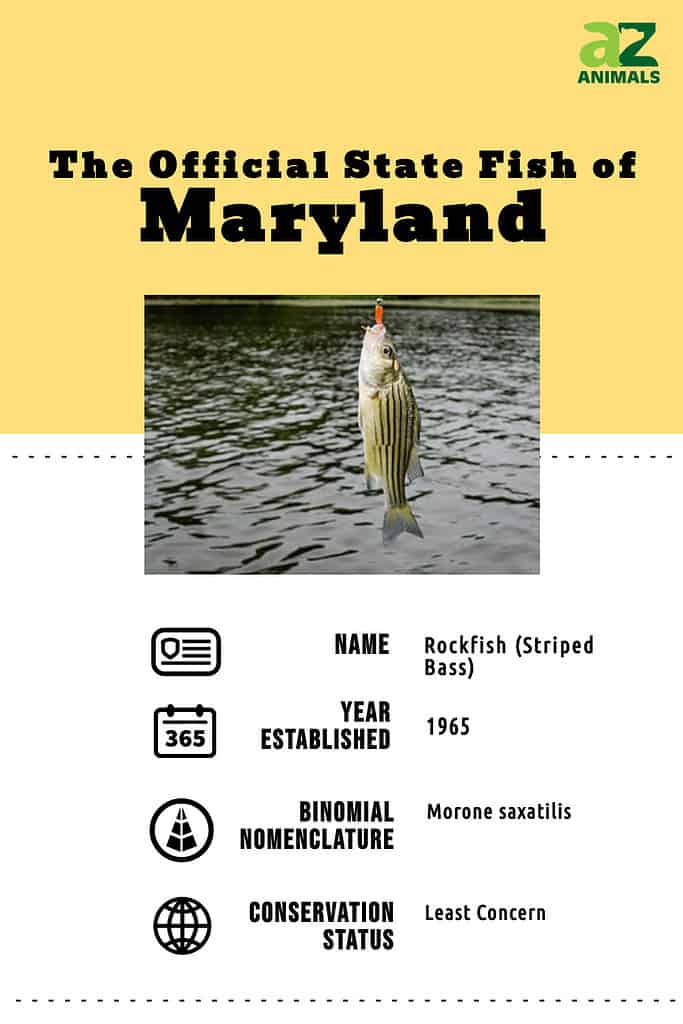
Characteristics and Habitat
Maryland named the rockfish (Morone saxatilis) the official state fish of Maryland in 1965. The rockfish is renowned for its striking appearance, featuring a silvery body with distinct dark, horizontal stripes along its sides. It possesses a robust, elongated body shape and can grow to impressive sizes, with some particular fish reaching lengths of over four feet and weighing more than 50 pounds.

The Striped Bass is an anadromous species migrating between saltwater and
freshwater
environments.
©Pelow Media/Shutterstock.com
Known for its size and fighting ability, the rockfish or Striped Bass has an olive-green backside, a fading to light silver color on its sides, and a white underside. Seven to eight continuous stripes run from head to tail. The species has board flattened head, a protruding lower jaw, and a deeply forked tail. These characteristics contribute to its exceptional swimming ability, making it an agile predator in the water.
The Striped Bass is an anadromous species migrating between saltwater and freshwater environments during different stages of its life cycle. It primarily resides in the Atlantic Ocean along the East Coast of North America, including the Chesapeake Bay, a vital habitat for the iconic fish.
The Chesapeake Bay
The Chesapeake Bay is a crucial spawning ground for the striped Bass, offering the necessary mix of saltwater and freshwater conditions. With its vast network of tributaries and abundant food sources, the bay system provides an ideal environment for the species to reproduce and grow. Rockfish play an essential job in the food web by controlling prey populations. In addition, the Rockfish population in Maryland’s waters contributes significantly to one of the Chesapeake Bay’s thriving commercial and recreational fisheries, generating substantial annual revenue in the region, amounting to hundreds of millions of dollars.

The
Chesapeake Bay
, with its mix of salt and fresh water, is a crucial spawning ground for the striped Bass,
©Keri Delaney/Shutterstock.com
Ecological Importance and Conservation
The Striped Bass plays a pivotal role in the ecological balance of the Chesapeake Bay and its surrounding ecosystems. As a predatory fish, it helps control the populations of smaller fish, maintaining a healthy balance within the food web. Furthermore, the annual migration of Striped Bass contributes to the dispersal of nutrients and energy throughout the Bay, influencing the productivity of various organisms and supporting the overall biodiversity of the region.
People must recognize the importance of conserving this iconic species; Maryland has implemented regulations and initiatives to safeguard the Striped Bass population. In recent years, concerns about declining stocks have led to implementing size and catch limits, seasonal restrictions, and other measures aimed at sustainable management. These efforts aim to protect the breeding stock, promote responsible fishing practices, and ensure the long-term viability of the fishery.

Maryland has implemented regulations and initiatives to safeguard the Striped Bass population.
©Steve Brigman/Shutterstock.com
People consider the rockfish the premier sport and commercial species on the Bay. The silver-flanked rockfish proves a challenge to even the most experienced fisherman. People love the rockfish as a challenge and a delight to eat. The current Maryland record for rockfish caught in the Chesapeake Bay weighed in at a whopping 67 pounds and 8 ounces in 1995. From 1985 to 1989, Maryland had to enforce a moratorium on harvesting rockfish due to dwindling stocks caused by overfishing and pollution. Although there has been an increase in the Rockfish population since then, stringent regulations remain in effect to safeguard the species’ survival in Maryland’s waters.
Cultural Significance
Recreational anglers regard the Striped Bass as highly prized. Fishing Enthusiasts from near and far flock to the waters of Maryland to attempt to catch the rockfish. Its strong fighting abilities and delicious white meat make it a favorite catch among sport fishermen. Pursuing this game, fish has become an integral part of Maryland’s fishing heritage, with numerous fishing tournaments, charter boat excursions, and shore-based angling opportunities available throughout the state. The excitement and camaraderie surrounding Striped Bass fishing contribute to the coastal culture of Maryland.
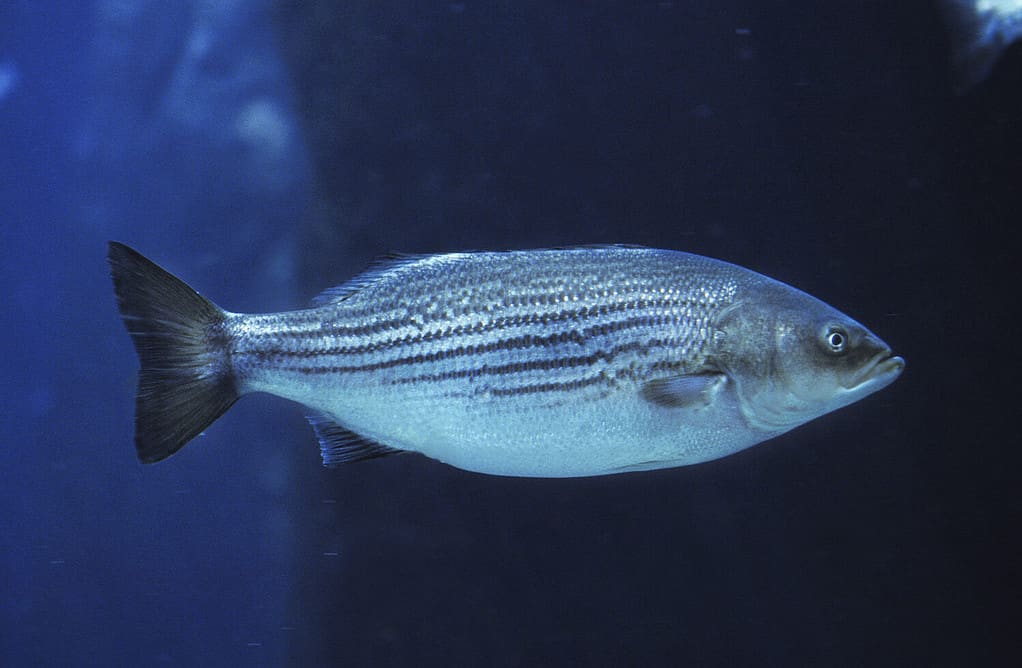
The Striped Bass is a symbol of local pride and the state’s deep connection to its maritime heritage.
©slowmotiongli/Shutterstock.com
Beyond its recreational value, the rockfish holds cultural significance for the people of Maryland. The people of Maryland recognize the Striped Bass as a symbol of local pride. People also see it as the state’s deep connection to its maritime heritage. Maryland’s rich history as a fighting community and its reliance on the Chesapeake Bay have intertwined with the story of the Striped Bass. This makes it an enduring icon of the state’s identity.
Guide to Rockfish Fishing in the Chesapeake Bay
Fishers consider the Chesapeake Bay one of the world’s greatest fisheries. The Bay consists of hundreds of rivers flowing to over 200 miles of protected waters and access to the Atlantic. The Bay is home to some truly impressive fish. However, the rockfish stands apart from all the other fish, and Chesapeake Bay rockfishing is considered an institution. Rockfish prove to be a fight even for the most experienced angler.
Like all types of bait, rockfish are everywhere in the Bay, so you will have no trouble casting your line. They inhabit the flats upstream to parks on the side of the Bay to piers, bridges, and charter boats.
Fly Fishing
Fly fishing for rockfish is reserved for the hardcore angler in the Chesapeake Bay. Anglers can hit the rivers, flats, or cast from shore. There are plenty of fish and lots of fun in the Bay.
Rockfish will take any bait, and that goes for fliers too. Use fast-sinking lines and heads, and keep your fly at the fish’s feeding level for the best chance at success. Ensure you are prepared for a fight because these creatures do everything they can to off the end of your line.
Fishing From a Shore or Pier
Don’t worry if you haven’t quite mastered the art of fly fishing. There are plenty of opportunities on conventional gear from shore. Bring your waders to the rivers and flats or hit the banks and parks that line the Bay’s shoreline. There are dozens of piers on all sides of the Chesapeake Bay. Cast your line around structures that draw plenty of nutrients and bait fish for your best bet.
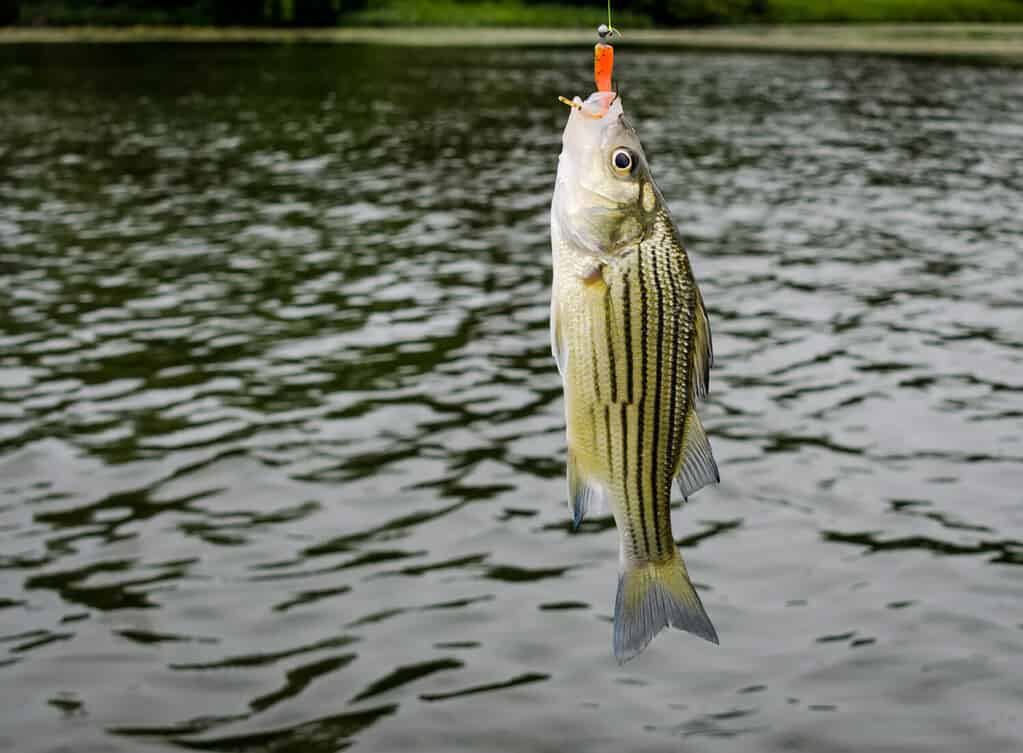
There are dozens of piers on all sides of the Chesapeake Bay.
©HildeAnna/Shutterstock.com
Trolling
Head out with a charter guide, and you’ll spend at least some time trolling. This practical way of targeting rockfish will see you drag multiple lines in the water behind the boat. That way, the bait will mimic the moves of the bait fish, enticing the bite of rockfish and more. When aboard such a vessel, you can cover a range of fishing grounds unimaginable on foot. Slow trolling with sandworms is most effective, meaning you can sit back and relax while the lines (and the engine) do all the work for you. Don’t let your guard drop, though, because you will need to leap into action on a moment’s notice as soon as you hear the reels screech and enter a battle like no other.
Where to Go for Chesapeake Bay Rockfish
Choosing a fishing spot in the expansive Chesapeake Bay can be challenging, given how big it is. However, the bright side is that no matter where you decide to cast your line, you can expect a rewarding fishing experience. To increase your chances of landing the renowned Chesapeake Bay Rockfish, it is essential to pay close attention to diving birds and leaping bait fish, as these indicators often lead to the presence of hungry Striped Bass.
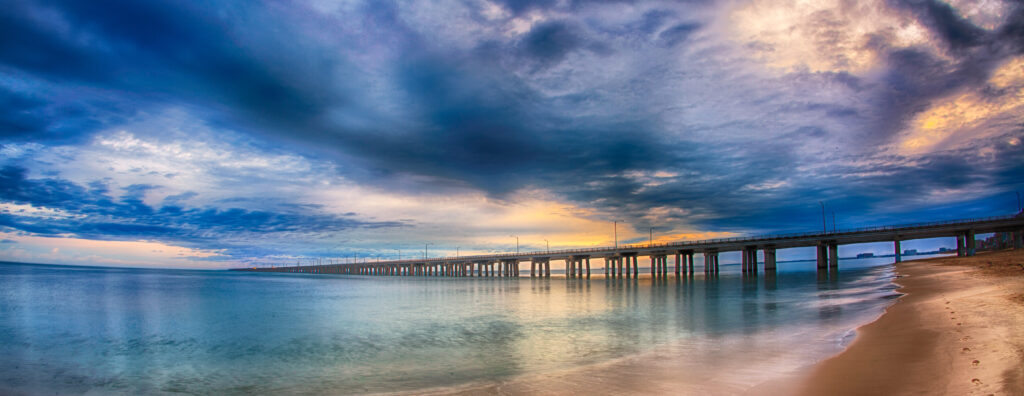
Early morning view of the Chesapeake Bay Bridge-Tunnel from Chick’s Beach
©Paul’s Photo Shop/Shutterstock.com
To maximize your fishing experience in the Chesapeake Bay, it’s helpful to understand its division into upper, middle, and lower sections. Here are the top recommendations for each region, where you can get the best value for your fishing adventure:
The Upper Chesapeake Bay
- Susquehanna Flats: Follow the course of the mighty Susquehanna River to this location, where targeting rockfish is particularly fruitful. Whether you opt for a light vessel or choose to wade in, you’ll have ample opportunities to cast your line for this prized fish.
- Rocky Point Beach: Enjoy the versatility of this picturesque fishing spot, with water depths ranging from 3 to 12 feet. Spend a day here, set up your camp, and reap the rewards of this abundant fishery.
- Battery Island: Embark on a charter boat and venture out to this remote island in the heart of the Bay. Not only will you be treated to the sight of a weathered lighthouse, but the fishing experience here is simply extraordinary.
The Middle Chesapeake Bay
- Bloody Point: This productive spot witnessed the capture of the Chesapeake Bay record rockfish. Its elongated land formation extending into the Bay makes it suitable for shore and charter fishing, with plentiful rewards awaiting you.
- Tilghman Island is another productive location that juts out into the Bay, offering Maryland’s finest fishing opportunities—delight in the abundance of delicious rockfish and more.
- Patuxent River: Located towards the Virginia border, this body of water teems with fish. For the best action, head to the river mouth, where you can expect an endless succession of rockfish catches.
The Lower Chesapeake Bay
- Cape Charles: From Creeks to the Bay, Cape Charles offers a diverse fishing experience. It is an ideal spot for trolling for rockfish, so sit back, relax, and immerse yourself in the action.
- Hampton Roads Bridge-Tunnel: This excellent angling location benefits from numerous rivers converging into the sea, providing abundant nutrients for bait fish and rockfish. Please make the most of it and enjoy the bountiful opportunities.
- Lynnhaven Inlet: True to its name, this protected body of water boasts calm seas and incredible fishing action. Explore the miles of shoreline or venture onto the water, and you’ll be in for a delightful treat.
By exploring these recommended spots across the Chesapeake Bay’s regions, you can increase your chances of a rewarding fishing experience while enjoying the breathtaking beauty of Maryland’s coastal waters.
Regulations
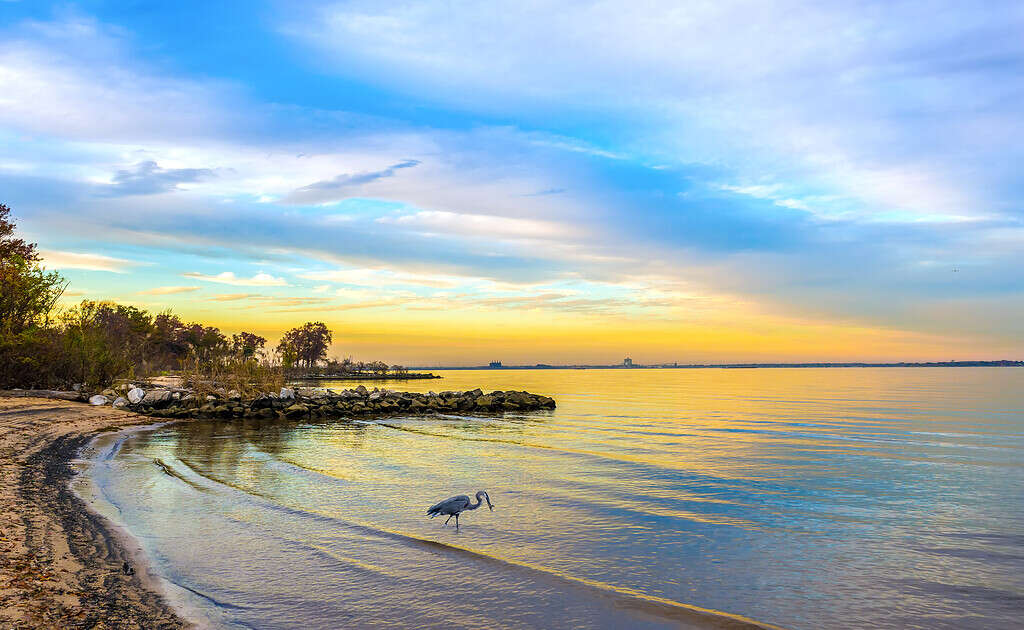
Maryland prohibits the harvesting of Rockfish in January, February, and April.
©iStock.com/flownaksala
It’s important to note that Virginia and Maryland have different regulations regarding rockfish retention. You can keep one rockfish year-round in Virginia, although there are varying size limits. On the other hand, Maryland prohibits the harvesting of Rockfish in January, February, and April. However, in May, you are allowed to keep one rockfish. After that, two rockfish per person are permitted, with varying size limits. To ensure compliance, referring to the specific regulations for both Maryland and Virginia is advisable.
The great news is that you can fish in the waters of both states with a single license. All you need to do is register with the Saltwater Angler Registry of the other state. Alternatively, you can visit the Maryland Department of Natural Resources (DNR) website to get your Maryland fishing license.
The photo featured at the top of this post is © slowmotiongli/Shutterstock.com
Thank you for reading! Have some feedback for us? Contact the AZ Animals editorial team.






